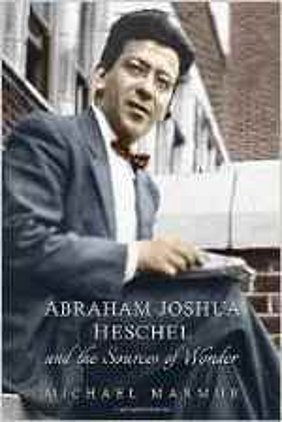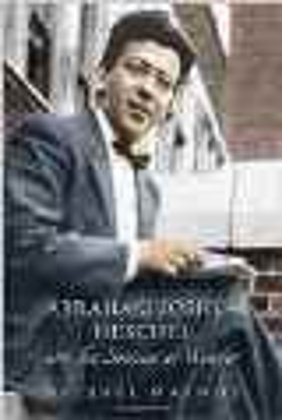Michael Marmur’s new book, Abraham Joshua Heschel and the Sources of Wonder, is a formidable achievement of scholarly analysis. The author explores the central themes of Heschel’s vast writings through tracking and exploring his creative deployment of earlier literary sources. The result is a stunning window into the workings of a dynamic exegetical soul. Marmur’s book introduces us to Heschel as a scholar, theologian, mystic, philosopher, and European rabbi committed simultaneously to the specific paths of Jewish thought as well as their universal (and universalist) vision. One crucial and underappreciated scholarly way of approaching these complex aspects of Heschel project, argues Marmur, is to understand how—and when—he marshals texts in order to formulate his theology.
Heschel is a particularly difficult thinker to define. The scion of illustrious Hasidic dynasties, he became one of the most important twentieth-century Jewish theologians in America. Raised in Warsaw, he made a home for himself in the cultures of Vilna, Berlin, Cincinnati, and eventually New York, but remained set apart from these worlds as well. Heschel contributed to the academic study of all areas of Jewish thought, and brought this vast erudition to bear in formulating his own spiritual vision. His writings inhabit the realms of scholarship and constructive theology; they cannot be easily reduced to one category or the other. Heschel’s entire oeuvre is united, however, in the careful and consistent use of earlier texts from the Bible to the Hasidic masters and beyond.
Given this vast corpus and literary flexibility, it is unsurprising that there is no single mode or determinative trajectory that governs Heschel’s uses of his sources. Marmur’s persuasive argument is that “Heschel’s work and life can be read as an attempt to model a Judaism of resonance out of its own sources” (p. 5). This approach thus complements the recent work of Shai Held, who examined Heschel in the context of twentieth-century philosophy.[1] Marmur offers a portrait of Heschel as an exponent of Jewish thought: “Heschel’s horizon looks to posterity, but it is rooted in what we might term ‘anterity,’ the multifaceted layers of tradition” (p. 13).
To illustrate Heschel’s hermeneutical approach, Marmur outlines six basic motivations that govern his practice of citation: 1) to express a sense of identification with and loyalty to his literary and religious tradition; 2) to revive bygone sages by introducing their writings to modern readers; 3) to demonstrate his erudition and command of the canonical sources; 4) to evince and garner authority; 5) to add aesthetic depth to his argument; and 6) to educate his readers (pp. 13-14). Although his evocative and illuminating writings are marbled with the full richness of the Judaic—and at times Western—literary corpa, Marmur’s methodical analysis now shows us that Heschel deployed these traditions in order to achieve a variety of goals integral to his theological project.
In exploring these various models of Heschel’s exegesis, Marmur’s book proceeds chronologically. Marmur takes up his writings on biblical theology, rabbinics, medieval philosophy, Kabbalah, and Hasidism and provides the reader with some excellent thematic insights in the final chapters. Even self-quotation, explains Marmur, is an important clue to understanding Heschel’s theology, since the practice of doing so across the years “suggests that for Heschel all parts of his oeuvre were interconnected” (p. 147).
A highly insightful reading of Heschel’s corpus emerges from this tack. Marmur demonstrates that Heschel generally cites biblical verses in order to shower the reader with its majesty and the profundity of scripture’s moral and theological vision rather than proffering original biblical exegesis. In his chapter on Heschel’s vision of rabbinics, Marmur correctly highlights key elements of rabbinic theology (the power of human deeds, the importance of aggadah), but notes also that—judging from his citations—“the Sages did not play a central part in his strategy for the revivification of Judaism in postwar America” (p. 50). Heschel chose to write about classical rabbinic literature only in Hebrew; rabbinic teachings, though they appear, are by no means the most common prooftexts in his English theological works. Yet, as Marmur astutely notes, Heschel’s writings are saturated with the flavor of rabbinic culture and its religious vision, a specific lens through which he interpreted the universalistic vision of the Hebrew Bible.
Marmur reconsiders Heschel’s complicated, ambiguous, fraught, and yet enduring engagement with the great Maimonides. Heschel was set dead against Maimonides’ dogmatic theology, his pure rationalism, and his austere God. But his deployment of sources make it clear that Heschel was also captivated by the Maimonides who explored the nature of prophecy, who daringly referred to wordless revelation in the Guide of the Perplexed, who emphasized the paramount importance of deeds and religious action. Similar insights abound throughout the book.
Marmur explores the ways in which Heschel’s social activism emerged from his relationship with the Jewish tradition, especially the prophetic legacy. Creative and highly attentive biblical interpretation led Heschel to embrace the possibility of—and indeed, speak with—a prophetic conscience and passionate commitment to morality that guided his involvement with civil rights and the struggle for Soviet Jewry, and his outspoken public opposition to the Vietnam War. The words of these Israelite prophets of old, repercussive and commanding, were a call against degradation and apathy. Heschel’s unique recasting of their message brought the spirit of the prophets, the Kabbalists, and the Hasidic masters into a contemporary ethos of outrage, pathos, and commitment to human flourishing in answer to a divine need.
The issue of universalism in Heschel’s writings is a very interesting one. Here Marmur has another significant contribution, showing that Heschel read the specific texts and ideas of Jewish literature in light of a universalistic ethos. Rather than reading the texts against the grain, however, Heschel seems to have believed that this broader message—timeless, in a sense—was the very essence of Jewish theology and morality.
Marmur notes, perhaps a bit too briefly, how Heschel’s Yiddish poetry anticipates these later developments. The optical imagery, the aspeklaria of Heschel’s later works, appears already, but in these works we find a prepossessing blend of biblical allusion, rabbinic turns of phrase, Hasidic devotion, and modern (and modernist) poetic introspection. Marmur might have highlighted these works in a chapter of their own, particularly as the early poems stand in such contradistinction to the Yiddish writings of Heschel’s final years.
I am confident that Marmur’s book will long be relevant. Heschel’s importance and popularity has continued to rise in recent years, including a flourishing of interest in Israel as more of his works are being translated into Hebrew. But the implications of Marmur’s study extend far beyond this specific exploration of Heschel’s writings. His examination of a particular Jewish figure contributes to our understanding of how modern religious thinkers shape—and are shaped by—the sources of their tradition through quotation and exegesis. Theologians are rooted in the sacred ground of tradition and formed by their intellectual and social context, but, for some, their interpretive vision spans eternities by reaching into the past in order to articulate the spiritual future. Noticing these hermeneutical developments and quiet revolutions requires that the scholar do far more than tally citations. This task demands sensitivity to the subtle poetics of language, in which allusory writing and evocative, edifying quotation enable a religious thinker’s words to speak multitudes.
The following formulation, offered by Marmur, is an excellent summary of Heschel’s entire project in a nutshell: “Heschel speaks in his own voice. It is a voice which resounds with echoes and cadences from many eras of Jewish tradition, and yet it is unmistakably and uniquely his. He gathered many of these sources and threads and created imagery, which he hoped would guide his contemporaries through the sensory overload of the modern condition. Judaism can serve as a multigenerational speculum, and instrument of sight” (p. 161).
Marmur’s book helps the contemporary reader to find Heschel’s voice, to deconstruct his writings in order to reveal the full extent of Heschel’s staggering erudition and command of Jewish—indeed, human—knowledge. But lest we be tempted toward a reductionist reading of Heschel’s project, Marmur once again leads us back to reexamine the forest whilst forgetting nothing of the trees. After closing Marmur’s book we hear Heschel’s voice once more, now seeing his writings as an original and rich chorus of textual undertones, shades of meaning, and exceptional creativity.



